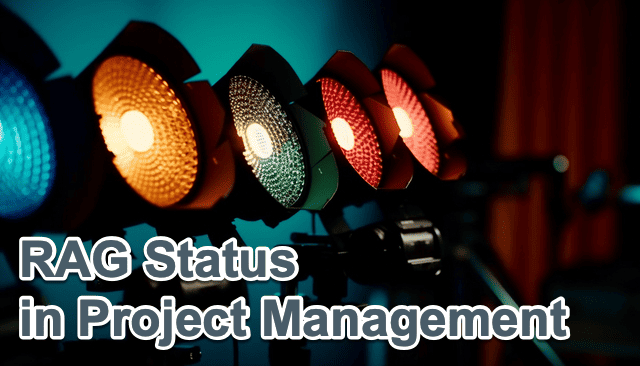
In project management, the RAG (Red, Amber, Green) status system is a pivotal tool for assessing and communicating project health. This intuitive method employs the simplicity of traffic light colors to indicate the state of a project, guiding managers in decision-making and stakeholder engagement. Understanding and effectively utilizing the RAG system can significantly enhance a project’s trajectory, ensuring timely interventions and informed strategies.

If you need a project management tool to manage your projects, give AceProject a try. Its pricing is not on a per-user basis so that you can have substantial savings in the long run.
10 Characteristics of RAG Status in Project Management
This overview delves into the nuances of RAG statuses, offering insights into their application and impact in steering projects toward successful completion.
1. What is RAG in Project Management?
The RAG system, standing for Red, Amber, Green, is a color-coded method for categorizing project status. It’s an intuitive and visual tool, reflecting the varying degrees of management action required. While some organizations include Blue (BRAG) for closed projects, others prefer RYG (Red, Yellow, Green). The key is that these colors serve as a quick reference for projects’ health and necessary actions.
2. Understanding a ‘Red’ Project
‘Red’ signifies a project facing significant challenges, such as budget overruns, schedule delays, or scope creep. It’s a call for immediate senior management intervention. Recognizing a Red project early is crucial to avoid further escalation of issues.
3. Actions for a Red Project
Reporting a project as Red is not an admission of failure but a strategic step for obtaining necessary support. Transparency with stakeholders, senior management engagement, and a thorough review of the project’s status are essential in forming an effective recovery plan.
4. Defining an ‘Amber’ Project
Amber indicates a project with some missed targets but, overall still within control. It’s a warning sign for potential issues, necessitating careful monitoring and proactive management to steer the project back on track.
5. Managing an Amber Project
For Amber projects, vigilance is key. Regular updates and a keen eye on project metrics help address issues before they escalate. It’s about balancing attention without overreacting.
6. Characteristics of a ‘Green’ Project
A Green project runs smoothly, meeting its budget and schedule targets without significant issues. It’s a sign of effective project management and should be validated with evidence to assure stakeholders.
7. Implementing RAG Statuses in Reports
RAG ratings, integrated into various reports (like weekly updates, risk reports, and board presentations), provide a quick snapshot of a project’s health. They help prioritize management focus and resource allocation.
8. The Simplicity of ‘RAGging’ Projects
‘RAGging’ a project means summarizing its status in a simple, color-coded format. Senior management particularly favors this approach for its brevity and clarity, offering an immediate understanding of project portfolios.
9. Reliability of RAG Reporting
The accuracy of RAG reporting hinges on the project manager’s honest assessment. A culture of transparency and accountability must prevail, ensuring realistic status reporting.
10. Handling Senior Stakeholders’ Reactions
Anticipating and managing senior stakeholders’ reactions to RAG statuses is vital to project communication. Pre-emptive discussions can mitigate surprise and facilitate constructive responses.
11. Incorporating RAG into Project Management Tools
Most modern project management tools support RAG status reporting inherently or through customizable features. This integration enhances the ease and consistency of reporting across projects.
12. Frequently Asked Questions
Addressing common queries about RAG reporting, such as its application, interpretation, and benefits, can further solidify understanding among project teams and stakeholders.
13. Sharing RAG Status with External Stakeholders
Deciding whether to share RAG statuses with external stakeholders depends on the project’s nature and the client’s relationship. Transparency can build trust, but it requires strategic consideration.
14. Next Steps for Project Managers
Project managers should embrace RAG reporting as a dynamic tool for effective communication and project control. Regularly updating and accurately reflecting project statuses in RAG reports can significantly improve project outcomes and stakeholder confidence.
Conclusion
In conclusion, RAG reporting in project management is not just a color-coding system; it’s a strategic approach to project communication and management. By accurately employing the RAG system, project managers can efficiently identify issues, allocate resources, and engage stakeholders, ultimately leading to more successful project outcomes and reduced investment wastage.
Suggested article: RAG Status and Its Crucial Role in Organizational Leadership
Daniel Raymond, a project manager with over 20 years of experience, is the former CEO of a successful software company called Websystems. With a strong background in managing complex projects, he applied his expertise to develop AceProject.com and Bridge24.com, innovative project management tools designed to streamline processes and improve productivity. Throughout his career, Daniel has consistently demonstrated a commitment to excellence and a passion for empowering teams to achieve their goals.